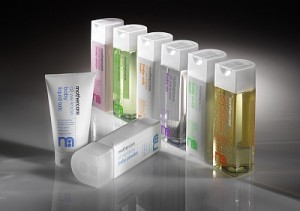Monday night saw the 2nd programme in the mini series High Street Dreams (8 programmes) on BBC1. The ‘reality TV show’ about product branding, packaging & design development. Over the series Jo Malone and Nick Leslau will help a number of individuals as they try to launch new products. From a packaging and design perspective, I don’t think that this week’s show was as good & fulfilling as the first, but still entertaining. The ‘guinea pigs’ included:
Primary school teachers from Shropshire – Jo Jones & Kay Miller who developed a ‘Den Kit’ – a fun and adventure product to help kids play & learn the old fashioned way! Good old ‘home farm’ values and fun!
Initially chopping trees down themselves in rural Shropshire to make ‘handmade’ wooden mallets, they proposed a huge retail price of £40 per pack. However after visiting the annual Toy Fair where the average toy price was £6.70, they were forced to reconsider. Their mentor David Strang, an entrepreneur & leading toy manufacturer, emphasised the importance of ‘eye catching’ packaging (good to hear!) which helped his own products increase sales by a factor of 25!
The ladies took this ‘on board’ and a “top graphic designer” was brought in to develop the branding, but I must say it left me disappointed. Although the typography was strong, with an ‘all over’ camouflage effect. Not sure that it had enough ’shelf stand-out, without any alluring photography or a means to view the products inside. But we didn’t have the benefit of a proper evaluation of competitor packs and ’sight’ of all packs on shelf together. Certainly if it had been our project we would have also considered other packaging options (rather than standard carton) to try and incorporate the above factors and try and add more consumer appeal, convenience & value.
The ladies did manage to get their costs down substantially by sourcing components from a brother in the Philippines. Enabling a revised price point of just under £30.
They christened their overarching brand as ‘Real Adventure’ & pitched to the MD Duncan Grant of the ‘Entertainer’ retail chain who was certainly ‘wavering’ and undecided on whether or not to stock the product. He loved the ‘down to earth’ product concept and I think that most of his concern was targeted at the packaging. He mentioned that the packaging needed “more work” but did eventually give the ‘ go-ahead’ to try out the products in his 52 high street stores in the UK.
The kit contains: tarpaulin, groundsheet, handmade mallet, tent pegs, tent peg bag, 10m rope, metal mug, camouflage paint, webbing haversack & instructions
Since filming, Jo & Kay have certainly been busy and now have other products featured on their website which you can see here: Flibberty
You can follow them on Twitter: @DenKit
The second product featured on the programme was Nutriyum. Husband and wife, Paul and Maria Stricker quit their lucrative city jobs and invested their life savings (over £15K) to create Nutriyum – a healthy drink for young kids. Developing a drink that is both nutritious and tasty is tough enough, but they had just eight weeks to formulate a product in order to secure themselves a place on the highly competitive supermarket shelves. They enlisted the expertise of Ella’s Kitchen founder Paul Lindley and Little Dish’s Hillary Graves to help them focus, but sadly time was against them and despite bags of enthusiasm, had failed to do their homework!!
The initial products offered by Paul & Maria were banana & strawberry flavours – but containing no fruit! The product was redeveloped within a matter of days from the previous synthetic mix into a chilled fresh fruit smoothie, which the couple were expecting to sell at the premium price of £1. Leslau affirmed the importance of pitching with a real product – NOT a prototype – something that we would strongly endorse. In our experience, retailers, buyers & marketers often find it difficult to visualise the ‘final product’, so it’s critical to get as close as possible with your product & packaging in any ’sales pitch’. Something that can be achieved quite easily these days with the ability to provide quick-turnaround physical mock-ups & realistic digitally printed artwork.
Leslau also emphasised the importance of gaining ’shelf space’ with retailers. I would also mention that stores sometimes measure profits in terms of the profit per length of shelving – which needs to be borne in mind in any pack design! Retailers need to be able to:
- Restrict their investment to the lines that will sell
- Buy in small quantities (keeping minimum stock)
- Buy goods that generate the highest levels of profit
Indeed we would emphasise the importance of meeting the business needs of all supply chain parties – suppliers, manufacturers, wholesalers, retailers & customers – all are interdependent.
Manufacturing was shown in more detail this week, as the young couple hired contract filling facilities to fill prototypes – at a cost of £5000 (+£1000 for materials) – only to come to the conclusion that they had been packed in an inappropriate packaging format (an expensive mistake to make and underlines the importance of thinking these things through properly and employing ‘experts’ to help from the outset – which can actually work out more cost-effective in the long run!)
The packs chosen for filling were Guala ’style’ ‘doy’ packs, commonly used on drinks like Lucozade, but would have presented the wrong ‘messages, cues & triggers’ for the ’single shot’ proposition intended. The branding agency chosen by Malone and Leslau were ‘Identica’ who (not surprisingly) struggled to find a fit with the brand name ‘Nutriyum’ and also with the overall pack proposition (considering that the product ingredients were synthetic but supposed to be healthy and appeal to young mothers). So there was a big ‘disconnect’ there. If more market research had been undertaken by the couple before developing their product/brand a totally different & more focused offering would have been achieved.
Ultimately, Paul & Maria realised their problem and simply ran out of time, so decided themselves to ‘bow out’ – a very brave decision considering the allure of retail endorsement and the TV PR coverage they would have gained for their new brand (despite that – they certainly got some good coverage anyway!). I feel that they made the right decision and will ‘live to fight another day’, once they’ve got it right.
As it happens, I undertook some research on the web today, and it does appear that the couple have been ‘beavering away’ in the background. Although the product is “not in the shops yet”, you can find out more about their endeavours on-line (link below). As a matter of interest Nutri-Yum does already appear to been trademarked by someone else (which wasn’t mentioned in the programme by anyone!) Paul & Maria do seem to have taken ‘on-board’ the comments made in the programme and redeveloped their branding & packaging (and no-doubt the formulation also). In fact a completely different product offering! Certainly an improvement on what was shown on the TV – but probably in need of a bit more work. The brand name has been changed to ‘nyum‘. According to Wikipedia, this means “Swallowing in Catalan” – which I suppose is reasonably appropriately. However, a quick search on Google, pulls up a huge array of ‘nyum nyum’ activity & ‘noise’ – much of which seems to relate to eating BUT none of which relates to this new brand – so I feel that more work is needed there guys! You can see the latest offering on their website www.nyum.co.uk
We wish all parties featured in the programme every success with their products, but the big learnings for anyone in their position are:
- Include product development & design specialists from the start if you want success (we can give you a free consultation if you are unsure)!
- Make your mistakes early on in the process, before you’ve spent too much money
- Learn from your mistakes
- Don’t be afraid to ‘pull the plug’ if it doesn’t feel right!
Next week the High Street Dreams team will help two sets of partners market fashion products. If you want to watch last night’s programme again you can download it on i-player here: 17th May programme
Cheers
Chris Penfold







